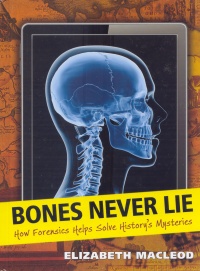| ________________
CM . . . . Volume XIX Number 40 . . . . June 14, 2013
excerpt:
Popular television programs and, to a lesser extent, daily news broadcasts and newspapers have brought the world of forensics and criminal investigation into the mainstream of everyday life. In an engaging fashion, Macleod illustrates how the tools of forensic investigators have recently been employed to try to solve mysteries surrounding the deaths of seven historic royals who lived on five continents dating from more than three millennia ago to the middle of the twentieth century. In each of the seven mysteries discussed, Macleod focuses upon a unique aspect of the "crime-solvers' arsenal." She provides factual and historical information about the techniques used, presents the nature of the mystery, examines the evidence available to officials past and present, and concludes with a verdict. The book is an interesting blend of mystery, history and science. The death of an entire royal Mayan family, led by Kan Maax prior to 800 CE in present day Guatemala, is the vehicle for discussing forensic archaeology and forensic anthropology. Since the excavation of the grave site only began in 2005, the tentative verdict on who committed the mass murder and why may be qualified further in the coming years as study continues and as investigative techniques continue to develop. The tale of Napoleon Bonaparte's death highlights the use of the autopsy. The mystery of who was the Man in the Iron Mask during the reign of Louis XIV in seventeenth century France emphasizes the use of deductive reasoning, an investigative tool that applies to all criminal investigations. This is one case that remains unsolved despite some tentative answers to the identity of the prisoner. The death of Thailand's King Rama VIII in Bangkok in 1946 is an excellent choice for exploring the importance of studying the crime scene and trying to preserve it in an unadulterated state. This is one of the most troubling case studies since three men were executed for the king's death, yet the evidence points to their innocence. Thai law that forbids discussion of the royal family helps to hinder any further exploration into the king's death. The mystery of the fate of the Grand Duchess Anastasia, a daughter of the last Russian czar, was eventually solved. DNA testing had previously proved that Anna Anderson, whom many believed was Anastasia, was in reality not related to the Romanovs. The grave and remains of Anastasia were finally uncovered in 2007 providing final proof of her fate. The case study discusses many tools used to help establish an identity, including facial comparison, dental records, handwriting analysis, fingerprinting, and DNA analysis. Medical imagery (CT scans) figures prominently in the study of the mummified remains of King Tut. Scientists could tell from these scans that he suffered from Kohler disease, a club foot, a cleft palate, an impacted wisdom tooth and a broken thigh bone. In 2010, DNA analysis of samples from the mummy identified the most likely cause of his death to be malaria. This verdict is corroborated by supporting evidence. The final case study explores the fate of Marie-Antoinette's son who was last seen alive in Temple Prison, Paris, in June of 1795. This case expands further upon the use of DNA analysis to prove and disprove identities. Limitations of the tool are exposed since the testing on a preserved heart believed to belong to the child, King Louis XVII, proved that it belonged to a child related to Marie-Antoinette, but deductive reasoning had to be used to help "officially" solve the case. Curious readers will devour this book which is attractively illustrated with appropriate colour and black and white photographs. Despite some inevitable repetition of content, notably the recurring use of DNA in forensic analysis, the cases are interesting, explain the historical situation concisely, and fulfil the object of teaching about the tools of forensic experts and criminal investigators. A forensics timeline, glossary, index, and two bibliographies, one of main monographic sources and a second on further sources contribute to the usefulness of this book for young scholars. Highly Recommended. Val Ken Lem is a collection services librarian at Ryerson University in Toronto, ON.
To comment
on this title or this review, send mail to cm@umanitoba.ca.
Copyright © the Manitoba Library Association. Reproduction for personal
use is permitted only if this copyright notice is maintained. Any
other reproduction is prohibited without permission.
NEXT REVIEW |
TABLE OF CONTENTS FOR THIS ISSUE
- June 14, 2013.
AUTHORS |
TITLES |
MEDIA REVIEWS |
PROFILES |
BACK ISSUES |
SEARCH |
CMARCHIVE |
HOME |
